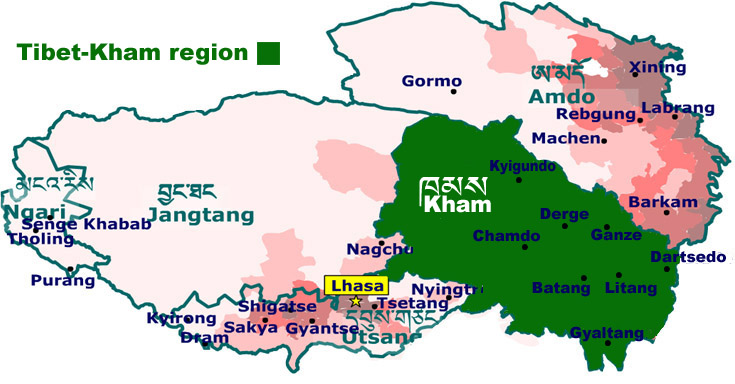Tibet >Kham
Information
 Far eastern Tibet (Kham) is the most densely populated region of the plateau - its inhabitants are distinguished from other Tibetans not only by their robust physical appearance, colourful dress and braided coiffure, but by distinctive dialects and social customs. The terrain is characterized by extremely rugged and glaciated snow mountains, ranging from northwest to southeast, broken by rich grassland pastures and deep forested gorges formed by the Salween, Mekong, Yangtze, and their numerous tributaries. The region's forty-seven counties are divided for political and historical reasons between four provinces, twenty-five of them in the Chamdo, Nakchu, and Nyangtri prefectures of the Tibet Autonomous Region, three in the Dechen Autonomous Prefecture of Yunnan, seventeen in the Kandze and Mili autonomous areas of Sichuan, and six in the Jyekundo Autonomous Prefecture of Qinghai.
Far eastern Tibet (Kham) is the most densely populated region of the plateau - its inhabitants are distinguished from other Tibetans not only by their robust physical appearance, colourful dress and braided coiffure, but by distinctive dialects and social customs. The terrain is characterized by extremely rugged and glaciated snow mountains, ranging from northwest to southeast, broken by rich grassland pastures and deep forested gorges formed by the Salween, Mekong, Yangtze, and their numerous tributaries. The region's forty-seven counties are divided for political and historical reasons between four provinces, twenty-five of them in the Chamdo, Nakchu, and Nyangtri prefectures of the Tibet Autonomous Region, three in the Dechen Autonomous Prefecture of Yunnan, seventeen in the Kandze and Mili autonomous areas of Sichuan, and six in the Jyekundo Autonomous Prefecture of Qinghai.
Access
There are several airports in Kham now. The first is in Ponda near Chamdo, the second is in Ganze near Dartsedo and the third one is in Yushu, Qinghai province. Most of the areas are accessible from Lhasa or the gateway cities (Chengdu, Kunming and Xining) on national highways: H109 passes through Nakchu, H 317 through Chamdo, Derge, Kandze and Dartsedo, H318 through Po-me, Markham, Batang and Litang, and H214 through Jyekundo, Nangchen, Chamdo, and Dechen.
Culture
The monasteries of Kham, far removed from the political cauldron of Lhasa, are fast rebuilding and extending their influence as far as the neo-Buddhist communities of mainland China. Among them, the Nyingmapa are strongest in Derge, Pelyul and Nyarong, the Kagyupa in Nangchen, Derge and Derong, the Sakyapa in Derge and Jyekundo, and the Gelukpa in Chamdo, Litang, Batang and the south. The pre-Buddhist Bon tradition still has a significant presence in the Khyungpo region of the upper Salween.basin.
Kham is a region where the pageantry of Buddhist and secular festivals is renowned. Sacred masked dances performed in the context of the drubchen ceremony are frequently held, exemplified by those at Katok commemorating the birth of Padmasambhava. Horse festivals, including officially sponsored events at Jyekundo and Litang are occasions for song, dance and sporting contests, at which boisterous Khampa crowds proudly display their local costume and traditions.
It is no exaggeration to say that each county has its unique focal points for pilgrimage - foremost among them being Kyadrak Senge Dzong in Dzachuka, Gawalung in Po-me, Mt Kawa Karpo in Dechen, Nabun Dzong in Nangchen, Yegyel Namka Dzong in Riwoche, Chakdu Khawa Lungring in Nyarong, Mt Zhara Lhatse in Minyak, Rudam Gangi Rawa at Dzogchen, Pema Shelphuk in Mesho, Tsandra Rinchen Drak at Pelpung, Katok Dorjeden near Pelyul, and Khampo Nenang near Litang.
